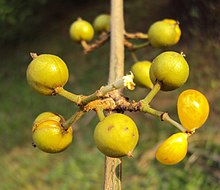Aporosa cardiosperma
| Aporosa cardiosperma | |
|---|---|

| |
| Fruits | |
| Scientific classification | |
| Kingdom: | Plantae |
| Clade: | Tracheophytes |
| Clade: | Angiosperms |
| Clade: | Eudicots |
| Clade: | Rosids |
| Order: | Malpighiales |
| Family: | Phyllanthaceae |
| Genus: | Aporosa |
| Species: | A. cardiosperma |
| Binomial name | |
| Aporosa cardiosperma (Gaertn.) Merr. | |
| Synonyms | |
| |
Aporosa cardiosperma is a species of plant in the family Phyllanthaceae. It is endemic to South-West India and Sri Lanka. The fruit has two seeds covered with sour gelatinous pulp that is fed on by birds (and edible for humans[2]) which disperse the seeds.[3] In the Western Ghats of India, the thin stems of the tree are often galled by Cecidomyiidae. An echinate gall formation has also been noted in Kerala.[4]
A herbal concoction of the leaves is used in traditional remedies for jaundice and other conditions. Antioxidant and hypoglycemia inducing properties of its extracts have been noted in laboratory studies.[5][6][7]
- Flowers
- Leaves
- Tree
- heart-shaped seed
- ripe fruit
References
- ^ World Conservation Monitoring Centre (2018). "Aporosa cardiosperma". IUCN Red List of Threatened Species. 2018: e.T33511A136127071. doi:10.2305/IUCN.UK.2018-2.RLTS.T33511A136127071.en. Retrieved 16 November 2021.
- ^ Hedrick, U.P., ed. (1919). Sturtevant's notes on edible plants. Albany: J.B. Lyon. p. 59.
- ^ Puyravaud, Jean‐Philippe; Dufour, Céline; Aravajy, Subramanian (2003). "Rain forest expansion mediated by successional processes in vegetation thickets in the Western Ghats of India". Journal of Biogeography. 30 (7): 1067–1080. doi:10.1046/j.1365-2699.2003.00882.x. ISSN 0305-0270.
- ^ Saleem, U.K.A.; Nasser, M. (2015-07-03). "Insect-induced galls of the Malabar bioregion, Southern India". Oriental Insects. 49 (3–4): 165–197. doi:10.1080/00305316.2015.1081420. ISSN 0030-5316.
- ^ Badami, Shrishailappa; Rai, Sujay R.; Suresh, B. (2005). "Antioxidant activity of Aporosa lindleyana root". Journal of Ethnopharmacology. 101 (1–3): 180–184. doi:10.1016/j.jep.2005.04.029.
- ^ Ali, Yakub; Alam, Mohammad Sarwar; Hamid, Hinna; Husain, Asif; Kharbanda, Chetna; Bano, Sameena; Nazreen, Syed; Haider, Saqlain (2014). "Attenuation of inflammatory mediators, oxidative stress and toxic risk evaluation of Aporosa lindleyana Baill bark extract". Journal of Ethnopharmacology. 155 (3): 1513–1521. doi:10.1016/j.jep.2014.07.035.
- ^ Jayakar, B.; Suresh, B. (2003). "Antihyperglycemic and hypoglycemic effect of Aporosa lindleyana in normal and alloxan induced diabetic rats". Journal of Ethnopharmacology. 84 (2–3): 247–249. doi:10.1016/S0378-8741(02)00328-8.






